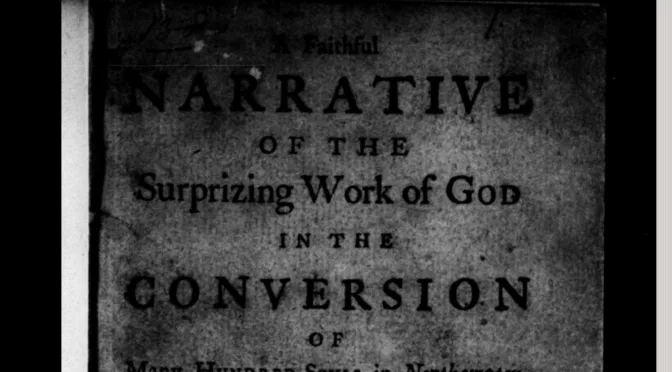[The referenced book in this article is available online in its entirety here: https://ccel.org/ccel/edwards/works1/works1.viii.html or https://archive.org/details/bim_eighteenth-century_a-faithful-narrative-of-_edwards-jonathan_1737?utm_source=chatgpt.com]
In 1734, in the quiet town of Northampton, Massachusetts, a remarkable work of God began under the ministry of Jonathan Edwards, a young preacher devoted to the truth of Scripture. What unfolded in the months that followed became one of the most extraordinary revivals in American history, transforming not only Northampton but sparking a movement that laid the foundation for the First Great Awakening.
Jonathan Edwards documented this revival in A Narrative of Surprising Conversions,capturing how God’s Spirit moved unexpectedly and powerfully. The revival began with Edwards’ faithful preaching of the Gospel, particularly his sermons on justification by faith and the beauty of Christ. These messages deeply convicted his congregation, awakening them to their sin and their desperate need for a Savior.
A Spark from Small Beginnings
The revival was ignited by the transformation of a few young people in the town who had been known for their worldly and careless ways. These individuals experienced dramatic conversions and began to gather in small prayer groups, seeking God fervently and encouraging one another to grow in faith. Their changed lives stirred curiosity and conviction in others, leading to a ripple effect throughout the community.
Edwards wrote, “The Spirit of God began extraordinarily to set in, and wonderfully to work among us.” The prayers of these small groups, often held in homes and fields, became a powerful force for revival. The sense of God’s presence became so tangible that it began to draw people into deeper personal worship and prayer.
A Community Transformed
By the winter of 1734-1735, the entire town of Northampton was gripped by a spiritual awakening. People of all ages and walks of life began to experience a profound awareness of their sin and the beauty of salvation in Christ. Edwards described how the town became “full of the presence of God,” with conversations in homes, shops, and streets centered on eternal matters.
Small prayer gatherings multiplied, and church services became packed with people weeping under conviction and crying out for God’s mercy. Edwards noted how entire families were transformed, with parents and children praying together and neighbors reconciling longstanding disputes. Within six months, nearly 300 people—about a quarter of Northampton’s population—professed faith in Christ.
This revival wasn’t marked by emotional excess but by genuine, heart-deep transformation. Edwards observed, “There was scarcely a single person in town, either old or young, left unconcerned about the great things of the eternal world.”
The Role of Small Prayer Groups
A distinctive feature of this revival was the importance of small prayer gatherings. These groups fostered intimacy, accountability, and a shared hunger for God’s presence. They became places where believers encouraged one another and interceded for their neighbors. Edwards recognized the role these prayer meetings played in sustaining the revival, writing that they kept the flame of spiritual fervor alive long after the initial spark.
This pattern of revival—beginning with a few who pray—aligns with biblical principles. In the early church, revival broke out at Pentecost after believers “were continually devoting themselves to prayer” (Acts 1:14, AMP). Similarly, in Northampton, God used small, humble gatherings to create a movement that transformed an entire town.
Ripples Beyond Northampton
The revival in Northampton didn’t stop there. The spiritual awakening spread to neighboring towns and eventually inspired preachers like George Whitefield and others, who carried the revival fire across New England and beyond. This wave of spiritual renewal became a key catalyst for the broader First Great Awakening, which swept through the colonies and led to widespread repentance, church growth, and a renewed sense of dependence on God.
Lessons for Today
The Northampton Revival offers timeless insights into how God moves:
1. The Power of Persistent Prayer
Small prayer groups, like those in Northampton, are the backbone of revival. Their prayers invite God’s Spirit to move and transform lives. “If My people… humble themselves, and pray and seek My face… then I will hear them from heaven” (2 Chronicles 7:14, AMP).
2. Faithful Preaching of the Gospel
Edwards’ focus on the cross, repentance, and the beauty of Christ reminds us that revival begins when God’s Word is boldly proclaimed. “For I determined to know nothing among you except Jesus Christ, and Him crucified” (1 Corinthians 2:2, AMP).
3. The Role of Unity and Obedience
Small groups brought people together, fostering unity and accountability. Revival flourishes where believers are unified in their pursuit of God’s will. “Behold, how good and how pleasant it is for brothers to dwell together in unity!” (Psalm 133:1, AMP).
4. Genuine Repentance Produces Transformation
Revival leads to lasting change, both individually and in the broader community. Families were restored, relationships reconciled, and society changed as the Gospel took root in people’s hearts.
A Spark for Our Time
The Northampton Revival reminds us that God often moves through small beginnings. Just as He used a few young people and their prayer gatherings to ignite a movement in 1734, He can do the same today. Revival begins when ordinary people humble themselves, seek God in prayer, and proclaim His truth boldly.
Prayer for Revival
Heavenly Father, we thank You for the testimony of the Northampton Revival and the way You moved through small prayer gatherings to transform lives. Stir our hearts to seek You with the same fervency and devotion. Help us to gather in prayer, preach Your Word faithfully, and hunger for Your presence. Pour out Your Spirit upon us, and let revival start in our hearts and spread to our communities. In Jesus’ name, Amen.

